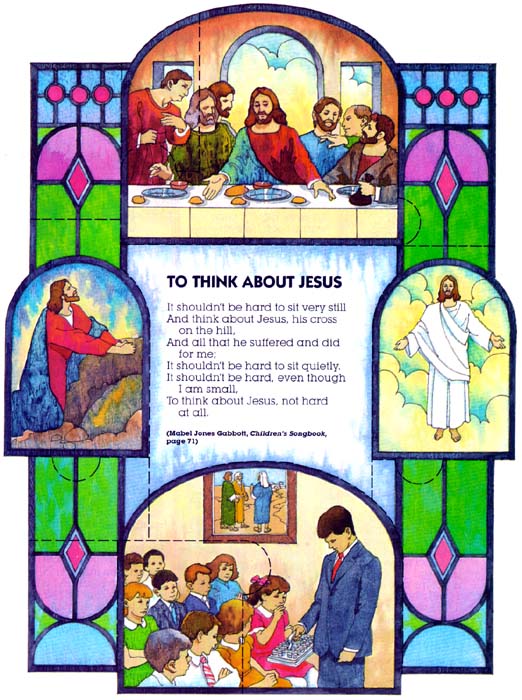“Sharing Time: On the Road to Emmaus,” Friend, May 1992, 14
Sharing Time:
On the Road to Emmaus
If ye do always remember me ye shall have my Spirit to be with you (3 Ne. 18:7).
On the third day after Jesus had been crucified, two of his disciples were walking from Jerusalem to a nearby village called Emmaus. As they walked, they talked about Jesus and about how He had been taken by the Roman soldiers. They talked about how He had been crucified by the Romans, and then tenderly placed in the sepulcher, or burying place, by His friends. They were confused because Mary Magdalene and some other women had told the disciples that the stone had been rolled away from the sepulcher, which was guarded by soldiers, and that Jesus’ body was gone.
As they walked, another traveler joined them. He asked them what they were talking about and why they were so sad. One of the disciples, Cleopas, couldn’t believe that the traveler had not heard about Jesus’ having been crucified. Cleopas told the traveler that the women had gone to the sepulcher and found it empty.
Then the traveler began to talk. He reminded them of all the scriptures that prophesied that a savior would come, teach people how to live, then die and rise from the dead, or be resurrected, so that all people could live again. As evening approached, the men neared the village of Emmaus. The two disciples asked the traveler to spend the night with them. He agreed. As they ate together, the two disciples realized that the traveler was the resurrected Jesus. He had been teaching them that He had risen from the dead just as the scriptures said He would. As soon as they understood this, He vanished from their sight.
“And they said one to another. Did not our heart burn within us, while he talked with us by the way, and while he opened to us the scriptures?” (Luke 24:32).
Cleopas and his friend had reverent feelings when they remembered Jesus Christ and what He had taught them during that day.
Every Sunday when we go to church, we can partake of the sacrament. In the sacrament prayers, we are told that if we will always remember Jesus Christ and keep His commandments, we will have His Spirit with us. We feel reverent when we remember Jesus Christ during the sacrament, just as His disciples of old felt reverent when they were with Him. When we partake of the sacrament reverently, we are worshipping Heavenly Father and Jesus.
Instructions: Carefully remove page 15 from the magazine and mount it on a piece of heavy paper. Cut it into puzzle pieces along the broken lines. When you put the puzzle together again, you will have the words to a song that will help you to remember Jesus Christ during the sacrament.

Illustrated by Jerry Harston
Sharing Time Ideas
-
Tell the story of the two disciples on the road to Emmaus. (See Luke 24:13–32.) Ask three children to act out the story as you tell it again. Discuss the kind of feelings the disciples might have had after their conversation with Jesus.
-
Show several pictures of children whose arms are folded. Have some of them thinking about Heavenly Father and Jesus, and some whose minds are wandering. On the backs write what the children are thinking about. These could be pictures drawn by the leaders or the children, or pictures found in the meetinghouse library or in the manuals (for example, CTR B, picture 50). Have the children guess what the children in the pictures may be thinking about. Turn the pictures over to reveal what the children are thinking. Make the point that “rev’rence is more than just quietly sitting” (Children’s Songbook, page 31).
-
Have younger children draw a picture, and older children write one sentence, identifying something specific that they will think about during sacrament meeting. Hang all of these on a mobile for display. Or have each child make several drawings or write several sentences and make his or her own mobile.
-
On separate pieces of paper, write different ways we can worship at church (singing, praying, listening, thinking, etc.). Give one paper to each class. Have each child in the class discuss his or her topic, then act it out with the help of his or her class. The other children can guess what they are doing to reverently worship Heavenly Father and Jesus.
-
Make sure that each child has a set of scriptures. Put the following references on the chalkboard: Psalm 96:1–2; Matthew 18:20; 3 Nephi 11:5–7; 3 Nephi 17:21–25; Moroni 4:3; and Moroni 5:2. [Ps. 96:1–2; Matt. 18:20; 3 Ne. 11:5–7; 3 Ne. 17:21–25; Moro. 4:3; Moro. 5:2] Give the older children time to find at least one of the scriptures, read it, and discover what it has to do with reverent feelings. Go through each scripture as a group, asking the children to share their discoveries.
To Think about Jesus
It shouldn’t be hard to sit very still
And think about Jesus, his cross on the hill,
And all that he suffered and did for me;
It shouldn’t be hard to sit quietly.
It shouldn’t be hard, even though I am small,
To think about Jesus, not hard at all.
(Mabel Jones Gabbott, Children’s Songbook, page 71.)